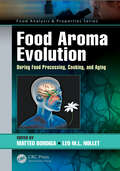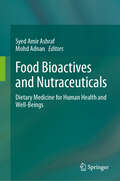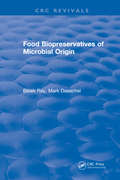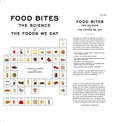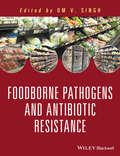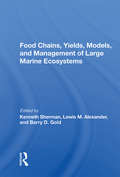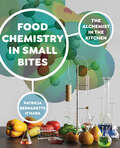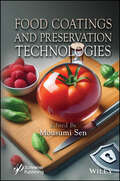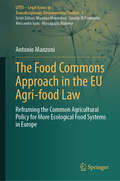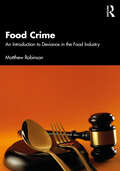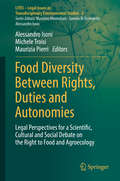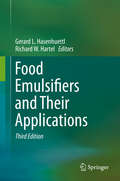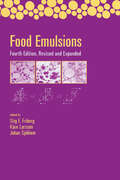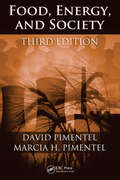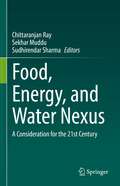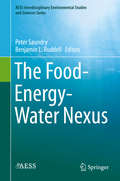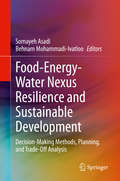- Table View
- List View
Food and the Immune System: Molecular Mechanisms and Nutritional Relevance in Health and Disease
by Christopher BeermannNutrition is an important environmental factor for the maturation of the human immune system and essential for maintaining immunological homeostasis. Based on this, a variety of food applications with medical claims are being generated by food manufacturers worldwide in order to expand the market potential of products creating interesting linkages with other market segments, such as cosmetics and pharmaceuticals. However, in addition to the health benefits, active principles of such components often remain unexplored.This book focusses on the specific interactions between food ingredients and the immune system along the entire immune defense response. Starting from the immune barrier, through the innate and adaptive immune response, to active limitation and termination, all major mechanisms of the immune response are addressed and different biochemical, cellular and genetic interactions of components of our diet are discussed. The book presents a wealth of disease patterns for which nutritional factors are relevant and thereby provides indications for potential intervention strategies. In addition, associated food-technological aspects are discussed. Being the first of its kind, this book provides an overview of the variety of functional food components and their influence on immunological responses. Written in an accessible style, it addresses researchers, health professionals and students with different scientific backgrounds.
Food Aroma Evolution: During Food Processing, Cooking, and Aging (Food Analysis & Properties)
by Matteo Bordiga, Leo M.L. NolletOf the five senses, smell is the most direct and food aromas are the key drivers of our flavor experience. They are crucial for the synergy of food and drinks. Up to 80% of what we call taste is actually aroma. Food Aroma Evolution: During Food Processing, Cooking, and Aging focuses on the description of the aroma evolution in several food matrices. Not only cooking, but also processing (such as fermentation) and aging are responsible for food aroma evolution. A comprehensive evaluation of foods requires that analytical techniques keep pace with the available technology. As a result, a major objective in the chemistry of food aroma is concerned with the application and continual development of analytical methods. This particularly important aspect is discussed in depth in a dedicated section of the book. Features Covers aromatic evolution of food as it is affected by treatment Focuses on food processing, cooking, and aging Describes both classic and new analytical techniques Explains how the flavor perception results are influenced by other food constituents The book comprises a good mix of referenced research with practical applications, also reporting case studies of these various applications of novel technologies. This text represents a comprehensive reference book for students, educators, researchers, food processors, and food industry personnel providing an up-to-date insight. The range of techniques and materials covered provides engineers and scientists working in the food industry with a valuable resource for their work. Also available in the Food Analysis & Properties Series: Ambient Mass Spectroscopy Techniques in Food and the Environment, edited by Leo M.L. Nollet and Basil K. Munjanja (ISBN: 9781138505568) Hyperspectral Imaging Analysis and Applications for Food Quality, edited by N.C. Basantia, Leo M.L. Nollet, and Mohammed Kamruzzaman (ISBN: 9781138630796) Fingerprinting Techniques in Food Authentication and Traceability, edited by Khwaja Salahuddin Siddiqi and Leo M.L. Nollet (ISBN: 9781138197671) For a complete list of books in this series, please visit our website at: www.crcpress.com/Food-Analysis--Properties/book-series/CRCFOODANPRO
Food as Medicine: Functional Food Plants of Africa (Functional Foods and Nutraceuticals)
by Maurice M. IwuThis comprehensive book documents African plants used for functional and medicinal foods. It contains more than 60 detailed monographs of African foods, describing foods with various characteristics such as prebiotic, probiotic, satiety, immune modulation, stress-reduction, sports performance, mental acuity, sleep-supporting, metabolic syndrome, antioxidant, and unsaturated fats. Plant description, botanical names and synonyms, plant part used, habitat and distribution, folk use, nutritional content, and chemistry are all fully detailed. The book highlights indigenous African food processing technologies up to the modern era.
Food Bioactives and Health (Food Bioactive Ingredients Ser.)
by Charis M. GalanakisBioactive natural compounds have gained attention in recent years due to their potential health benefits, including reducing the risk of diabetes, cancer, and cardiovascular diseases. These benefits derive from bioactive compounds' anti-tumor, anti-inflammatory, anti-oxidative, anti-hypertensive and anti-hyperlipidemic activities, which serve in addition to their basic nutritional functions. Over the last decade, researchers have investigated the health impact of bioactive compounds in detail, and the development of food applications has attracted great interest. Consumer demand has surged for functional foods (nutraceuticals), superfoods, and tailor-made foods, generated by supplementing traditional food products with bioactive ingredients. Food Bioactives and Health offers comprehensive coverage of the properties and health effects of food bioactives in view of new trends in processing, food science and food technology. Starting with the metabolic characteristics of polyphenols, glucosinolates, and other food bioactives, the text then dives into their impact on human health and recent applications in the world of food technology. For food scientists, food technologists, and product developers looking to understand the role of food bioactives in health and develop applications in personalized nutrition, functional foods and nutraceuticals, Food Bioactives and Health serves as a one-stop reference.
Food Bioactives and Nutraceuticals: Dietary Medicine for Human Health and Well-Beings
by Syed Amir Ashraf Mohd AdnanThis book examines nutraceuticals derived from plant, animal, or microbial sources, and presenting significant opportunities for food scientists and industry professionals to develop innovative foods or food components that address future human wellness and well-being requirements. These nutraceuticals can be specifically identified as antioxidants, dietary fiber, prebiotics, polyunsaturated fatty acids, probiotics, vitamins, polyphenols, and spices. The book also intends to consolidate current research and reviews on bioactive components inherent in traditional foods, highlighting their nutraceutical significance for promoting a healthy lifestyle. Moreover, it elaborates on the potential therapeutic applications of food bioactives as next-generation nutraceuticals sourced from novel origins. Emphasis is placed on various aspects of food bioactive compounds, exploring their prospective roles in the formulation of nutraceuticals aimed at enhancing human health and wellness, while also evaluating their potential in the management and prevention of metabolic disorders. Furthermore, the volume acknowledges the clinical implications of nutraceuticals, including their prospective applications within the food and pharmaceutical industries.
Food Biopreservatives of Microbial Origin
by Bibek RayFood Biopreservatives of Microbial Origin provides basic and applied information regarding how antimicrobial metabolites of safe, food-grade bacteria (used in food fermentation) can be utilized as food preservatives. The authors discuss why biopreservation of food is important, identify the foods and microoganisms for which biopreservation is suitable, and explore the potential of bacteriocins of food-grade starter culture bacteria and the antimicrobial proteins of yeasts as possible food biopreservatives. The book is a valuable reference resource that will benefit students of food science and researchers in food industries, regulatory agencies, and advisory groups.
Food Bites
by Richard W Hartel Annakate HartelFood Bites is an easy-to-read, often humorous book on the scientific basis of the foods we eat, and answers those pesky, niggling questions such as: Is the quality of beer really affected by the type of water used? and Processed foods: good or bad? Readers will be captivated by this superbly written book, especially so as their guides are Professor Richard Hartel, professor of Food Engineering at UW-Madison, along with his daughter, AnnaKate Hartel. Professor Hartel has for the last four years penned a witty and illuminating column on all aspects of food science for the Capital Times of Madison, and his weekly wisdom has now been collected into a single publication. With a huge and growing interest in the science of food, this treasure trove of knowledge and practical information, in 60 bite-sized chunks, is sure to be a bestseller.
Food-Borne Pathogens
by Catherine AdleyA collection of readily reproducible classic and emerging molecular methods for the laboratory isolation and identification of the pathogens, viruses, and parasites that cause food-borne disease. Among the pathogens covered are specific bacteria, including Salmonella spp, Campylobacter spp., Listeria spp., and Bacillus spp.; viruses, including noroviruses and enteroviruses; and parasites, including Cryptosporidium and seafood nematode worms. The protocols follow the successful Methods in BiotechnologyTM series format, each offering step-by-step laboratory instructions, an introduction outlining the principles behind the technique, lists of the necessary equipment and reagents, and tips on troubleshooting and avoiding known pitfalls.
Food Borne Pathogens and Antibiotic Resistance
by Om V. SinghFood is an essential means for humans and other animals to acquire the necessary elements needed for survival. However, it is also a transport vehicle for foodborne pathogens, which can pose great threats to human health. Use of antibiotics has been enhanced in the human health system; however, selective pressure among bacteria allows the development for antibiotic resistance. Foodborne Pathogens and Antibiotic Resistance bridges technological gaps, focusing on critical aspects of foodborne pathogen detection and mechanisms regulating antibiotic resistance that are relevant to human health and foodborne illnesses This groundbreaking guide:• Introduces the microbial presence on variety of food items for human and animal consumption.• Provides the detection strategies to screen and identify the variety of food pathogens in addition to reviews the literature. • Provides microbial molecular mechanism of food spoilage along with molecular mechanism of microorganisms acquiring antibiotic resistance in food.• Discusses systems biology of food borne pathogens in terms of detection and food spoilage.• Discusses FDA’s regulations and Hazard Analysis and Critical Control Point (HACCP) towards challenges and possibilities of developing global food safety. Foodborne Pathogens and Antibiotic Resistance is an immensely useful resource for graduate students and researchers in the food science, food microbiology, microbiology, and industrial biotechnology.
Food Chains, Yields, Models, And Management Of Large Marine Ecosoystems
by Kenneth ShermanDraws on case studies from tropical, temperate, and Arctic waters around the world, comparing multispecies biomass yield models for various large marine ecosystems. Emphasis is given to adaptive management as a strategy for maximizing the sustainability and productivity of living marine resources.
Food Chemistry: A Laboratory Manual
by Dennis D. Miller C. K. YeungFOOD CHEMISTRY A manual designed for Food Chemistry Laboratory courses that meet Institute of Food Technologists undergraduate education standards for degrees in Food Science In the newly revised second edition of Food Chemistry: A Laboratory Manual, two professors with a combined 50 years of experience teaching food chemistry and dairy chemistry laboratory courses deliver an in-depth exploration of the fundamental chemical principles that govern the relationships between the composition of foods and food ingredients and their functional, nutritional, and sensory properties. Readers will discover practical laboratory exercises, methods, and techniques that are commonly employed in food chemistry research and food product development. Every chapter offers introductory summaries of key methodological concepts and interpretations of the results obtained from food experiments. The book provides a supplementary online Instructor’s Guide useful for adopting professors that includes a Solutions Manual and Preparation Manual for laboratory sessions. The latest edition presents additional experiments, updated background material and references, expanded end-of-chapter problem sets, expanded use of chemical structures, and: A thorough emphasis on practical food chemistry problems encountered in food processing, storage, transportation, and preparation Comprehensive explorations of complex interactions between food components beyond simply measuring concentrations Additional experiments, references, and chemical structures Numerous laboratory exercises sufficient for a one-semester course Perfect for students of food science and technology, Food Chemistry: A Laboratory Manual will also earn a place in the libraries of food chemists, food product developers, analytical chemists, lab technicians, food safety and processing professionals, and food engineers.
Food Chemistry in Small Bites: The Alchemist in the Kitchen
by Patricia B O'HaraFood Chemistry in Small Bites takes readers on an up-close scientific journey through the transformation of food when meals are prepared. Organized in bite-size, digestible units, this innovative text introduces students to food's molecular makeup as well as the perception of food by the five senses. Using familiar foods as examples, it explores what happens to ingredients when heated, cooled, or treated and also considers what happens when materials that don’t naturally mix are forced to do so. With informative, full-color renderings and a hands-on lab section, the book encourages students to think like scientists while preparing delicious dishes. Readers will formulate hypotheses as to why certain foods taste hot despite being at room temperature, why milk separates into curds and whey when lemon is added, and other ordinary but chemically complex phenomena. This book also importantly challenges readers to think critically about the future of food in the face of a warming planet.
Food Coatings and Preservation Technologies
by Mousumi SenThis book compiles recent studies about edible coatings and how they have improved food products, packaging techniques, and product quality to cause fewer health risks. Food Coatings and Preservation Technologies presents the most recent studies about the application of edible coatings to a wide variety of foods. Edible coatings are globally utilized for preventing food product contamination from harmful microorganisms and pathogens. This book highlights the developments made in designing new edible coatings. Herein, particular attention is given to the main components, manufacturing methods, and their application to specific products. The book also discusses the current state-of-the-art alternative to conventional package usage, providing the main features biodegradable packaging should meet for distinct uses for the conservation and improvement of various food products. This information will be helpful for processors to select the best coating material and its effective concentration for different fresh and minimal processed vegetables. Each chapter delves into edible-based coating research and critical developments to enhance food preservation standards. The first section focuses on biopolymer-based edible coatings, food packaging, and preservation. It provides a comprehensive understanding of the current state and critical developments in biodegradable polymer packaging systems for food applications. As technology advances, the next section highlights ongoing research focusing on optimizing coating effectiveness and the development of eco-friendly and sustainable materials. This section’s objective is to identify edible materials and combine the most recent information available to provide a comprehensive understanding of formulation methods and approaches to enhancing the properties of the coatings applied to food products. The final section discusses encapsulation techniques and levels of retention to improve shelf-life. Readers will find in this book information concerning: The efficiency and functional properties of edible coating materials; Feasibility studies performed on new process evaluation, safety and toxicity determination, regulatory assessment, and consumer studies regarding the commercial uses of edible coatings; Coating technologies that present a promising avenue to enhance the delivery, stability, and efficacy of medical foods and nutraceuticals; Shelf-life testing that suggests future directions; Novel practical and reliable tools that are applicable in the industrial process. Audience The book is aimed at chemists, food technologists, food scientists, nutritionists, dietitians, pharmaceutical technologists, biochemists, and engineers, as well as postgraduate, PhD students and postdocs working in the area of edible food coatings and prevention technologies.
The Food Commons Approach in the EU Agri-food Law: Reframing the Common Agricultural Policy for More Ecological Food Systems in Europe (LITES - Legal Issues in Transdisciplinary Environmental Studies #3)
by Antonio ManzoniThis book presents a thorough analysis of the innovative food commons approach in relation to the EU Common Agricultural Policy (CAP). The debates surrounding this pivotal European policy have always been robust, and with the ambitious targets outlined by the UN Sustainable Development Goals and the European Green Deal, they are poised to become even more prominent. To effectively realize these objectives, it is imperative to systematically reassess the fundamental structures of our food systems and enact substantive reforms within EU agri-food law and policymaking. The food commons approach represents not only a novel theoretical framework, but also, and foremost, a dynamic socio-political movement that has garnered attention from both researchers and policymakers due to its pioneering nature. Rejecting the prevailing paradigm of absolute commodification of food, this approach endeavours to reconceptualize our food systems through the prisms of ecology, social inclusion, collective governance, and resilience. The overarching objective of this book is to scrutinize the potential of this novel approach to fundamentally reshape the theoretical underpinnings of EU agri-food law, ultimately facilitating the realization of more sustainable and just food systems. The target audience of this book mainly consists of academic researchers, but also practitioners and policymakers working on agricultural and environmental studies, due to its interdisciplinary approach and the originality of its content. Along the same lines, the book will appeal to NGOs, indigenous peoples, and food sovereignty movements around the world.
Food Crime: An Introduction to Deviance in the Food Industry
by Matthew RobinsonThis book addresses the various forms of deviance and criminality found within the conventional food system. This system—made up of numerous producers, processors, distributors, and retailers of food—has significant, far-reaching consequences bearing upon the environment and society.Food Crime broadly outlines the processes and impacts of this food system most relevant for the academic discipline of criminology, with a focus on the negative health outcomes of the US diet (e.g., obesity and diabetes) and negative outcomes associated with the system itself (e.g., environmental degradation). The author introduces the concept of "food criminology," a new branch of criminology dedicated to the study of deviance in the food industry. Demonstrating the deviance and criminality involved in many parts of the conventional food system, this book is the first to provide exhaustive coverage of the major issues related to what can be considered food crime. Embedded in the context of state-corporate criminality, the concepts and practices exposed in this book bring attention to harms associated with the conventional food system and illustrate the degree of culpability of food companies and government agencies for these harms.This book is of interest to students, scholars, and practitioners seeking a more just and healthy food system and encourages further future research into food crimes in the disciplines of criminology, criminal justice, and sociology.
Food Diversity Between Rights, Duties and Autonomies: Legal Perspectives For A Scientific, Cultural And Social Debate On The Right To Food And Agroecology (Lites - Legal Issues In Transdisciplinary Environmental Studies #2)
by Maurizia Pierri Michele Troisi Alessandro IsoniThe book reflects on the issues concerning, on the one hand, the difficulty in feeding an ever- increasing world population and, on the other hand, the need to build new productive systems able to protect the planet from overexploitation. The concept of “food diversity” is a synthesis of diversities: biodiversity of ecological sources of food supply; socio-territorial diversity; and cultural diversity of food traditions. In keeping with this transdisciplinary perspective, the book collects a large number of contributions that examine, firstly the relationships between agrobiodiversity, rural sustainable systems and food diversity; and secondly, the issues concerning typicality (food specialties/food identities), rural development and territorial communities. Lastly, it explores legal questions concerning the regulations aiming to protect both the food diversity and the right to food, in the light of the political, economic and social implications related to the problem of feeding the world population, while at the same time respecting local communities’ rights, especially in the developing countries. The book collects the works of legal scholars, agroecologists, historians and sociologists from around the globe.
Food Emulsifiers and Their Applications
by Gerard L. Hasenhuettl Richard W. HartelEmulsifiers, also known as surfactants, are often added to processed foods to improve stability, texture, or shelf life. These additives are regulated by national agencies, such as the FDA, or multi-national authorities, such as the EEC or WHO. The amphiphilic molecules function by assisting the dispersion of mutually insoluble phases and stabilizing the resulting colloids, emulsions, and foams. Emulsifiers can interact with other food components such as carbohydrates, proteins, water, and ions to produce complexes and mesophases. These interactions may enhance or disrupt structures and affect functional properties of finished foods. In dairy processing, small molecule emulsifiers may displace dairy proteins from oil/water and air/water interfaces, which affects stability and properties of the foams and emulsions. In baked products, emulsifiers contribute to secondary functionalities, such as dough strengthening and anti-staling. Synthetic food emulsifiers suffer from the stigma of chemical names on a product’s ingredient statement. Modern consumers are seeking products that are “all natural.” Fortunately, there are a number of natural ingredients that are surface-active, such as lecithin, milk proteins, and some protein-containing hydrocolloids. Mayonnaise, for example, is stabilized by egg yolk. This book can serve as both a guide for professionals in the food industry to provide an understanding of emulsifier functionality, and a stimulus for further innovation. Students of food science will find this to be a valuable resource.
Food Emulsions (Food Science and Technology)
by Stig E. Friberg Kåre Larsson Johan SjöblomUpholding the standards that made previous editions so popular, this reference focuses on current strategies to analyze the functionality and performance of food emulsions and explores recent developments in emulsion science that have advanced food research and development. Written by leading specialists in the field, the Fourth Edition probes the latest technologies in food emulsion assessment for excellence in food product design and focuses on methods of emulsion characterization and investigation. It contains new discussions on droplet analysis, surface forces, and the rheology of emulsions and examines essential components of everyday foods such as breads, condiments, margarine, and cheese.
Food, Energy, and Society
by David Pimentel Marcia H. PimentelSince the publication of the first edition of Food, Energy, and Society, the world's natural resources have become even more diminished due to the rapid expansion of the global human population. We are faced with dwindling food supplies in certain geographic areas, increasing pressure on energy resources, and the imminent extinction of many
Food, Energy, and Water Nexus: A Consideration for the 21st Century
by Chittaranjan Ray Sekhar Muddu Sudhirendar SharmaIn this book, major issues surrounding importance of water and energy for food security in the United States and India are described representing two extremes in yield, irrigation efficiency, and automation. The farming systems in these two countries face different risks in terms of climatic shifts and systems’ resiliency to handle the shocks. One may have comparative advantage over the other, but both are susceptible. Innovations in irrigation for food and fuel production, improvements in nitrogen and water use efficiency, and rural sociological issues are discussed here. We also look into some of the unintended consequences of high productivity agriculture in terms of surface and ground water quality and impacts on ecosystem services. Finally, we present ways to move forward to meet the food demands in the next half-century in both countries. As the current world population of 7 billion is expected to reach or exceed 10 billion in the next 40 years, there will be significant additional demand for food. A rising middle class and its preference for a meat-based diet also increases the demand for animal feed. This additional food and feed production needs special considerations in water and energy management besides the development of appropriate crop hybrids to withstand future climatic shifts and other environmental factors. A resilient agricultural landscapes will also be needed to withstand climatic fluctuations, disease pressures, etc. While the upper and many middle income countries have made significant improvements in crop yield due to pressurized irrigation and automation in farming systems, the lower income countries are struggling with yield enhancements due to such limitations. The rise in population is expected to be more in Sub-Sharan Africa and Middle East (Low to middle-income countries) where the crop yields are expected to be low.
The Food-Energy-Water Nexus (AESS Interdisciplinary Environmental Studies and Sciences Series)
by Peter Saundry Benjamin L. RuddellThis will be the first textbook on the integration of food, energy and water systems (FEWS). In recent years, the world has seen a dramatic rise in interdisciplinary energy and environmental courses and degrees at the undergraduate and graduate levels. In the US for instance, the number and variety of such programs has increased significantly over the past decade, Simultaneously, national and international initiatives that integrate food, energy and water systems have been launched. This textbook provides a substantive introduction to the food-energy-water nexus suitable for use in higher level undergraduate and graduate level courses and for scholars moving into the field of nexus studies without a strong background in all three areas and the many aspects of nexus studies.
Food-Energy-Water Nexus Resilience and Sustainable Development: Decision-Making Methods, Planning, and Trade-Off Analysis
by Behnam Mohammadi-Ivatloo Somayeh AsadiThis book presents readers with an integrated modeling approach for analyzing and understanding the interconnection of water, energy, and food resources and discusses the relationship between resilience and sustainability of the food- energy –water (FEW) system. Authors provide novel frameworks, models, and algorithms designed to balance the theoretical and applicative aspects of each chapter. The book covers an integrated modeling approach for FEW systems along with developed methods, codes, and planning tools for designing interdependent energy, water and food systems. In-depth chapters discuss the impact of renewable energy resources in FEW systems, sustainable design and operation, net zero energy buildings, and challenges and opportunities of the FEW nexus in the sustainable development of different countries. This book is useful for graduate students, researchers, and engineers seeking to understand how sustainable FEW systems contribute to the resilience of these systems and help policy and design makers allocate and prioritize resources in an integrated manner across the food, energy, and water sectors.
Food Engineering Interfaces
by Daniela Bermudez Aguirre Jorge Welti-Chanes José Miguel Aguilera Ricardo Simpson Gustavo Barbosa-CanovasThe International Conference on Food Engineering is held every four years and draws global participation. ICEF 10 will be held in April 2008 in Chile with the theme of food engineering at interfaces. This will not be a typical proceedings with uneven contributions. Papers will be solicited from each plenary speaker plus two or three invited speakers from each topic and the goal is to publish a book that conveys the interdisciplinary spirit of the meeting as well as covers the topics in depth, creating a strong reference work. The idea is to explore how food engineers have to be prepared in years ahead not only to perform in their normal activities but also to engage in new challenges and opportunities that will make the profession more attractive, responsive, and able to create a larger impact. These challenges and opportunities are within the profession and at interfaces with other areas. A major role of engineers is to incorporate new knowledge into the profession and respond to practical needs. The goal is to explore how food engineers are integrating developments in the basic sciences of physics and chemistry, nutrition, informatics, material sciences, genomics (and other -omics), quality and safety, consumer behavior and gastronomy. Interfaces with the environment, the business sector, regulations and export markets are also important to consider.
Food Engineering Principles and Practices: A One-Semester Course
by Syed S. RizviThis textbook is designed for a one-semester course on Food Engineering, and it offers a concise, in-depth and integrated introduction to the fundamental engineering and physicochemical principles and practices of utility in food processing and manufacturing operations. The textbook includes topics mandated by the Institute of Food Technologists for accreditation of Food Science curricula and helps prepare the students better for taking advance courses related to unit operations in food manufacturing. It is also relevant for Food Process Engineering courses, containing materials that most instructors can cover in three semester hours of instruction. In the first three chapters, readers will find an overview of the basic knowledge of physics and chemistry and an introduction to the engineering language needed to eliminate confusion going forward. In the following chapters, the author covers the main concepts of food thermodynamics, heat transfer–radiation in foodmaterials, mass transfer and fluid dynamics in food, along with real-life examples and exercises to help students relate better to the topics. The author also gives a brief introduction to the main mathematical and analytical concepts required in food engineering.This textbook equips readers to understand a diversity of food engineering related topics and each chapter is enriched with practical examples and Check Your Understanding sections, as well as several problems. The textbook is aimed at undergraduate food science students in their first required introductory food engineering course, but practitioners involved in designing, optimizing, and managing the processing of food products will also find it a useful account.
Food, Environmental Degradation and Injustices: How the Way We Eat Will Destroy Us (Palgrave Studies in Green Criminology)
by Simon SneddonWhat if the global trade in key food commodities suddenly ceased? This book takes readers on a thought-provoking journey through the environmental, ethical, and social justice issues embedded in our food systems. From meat and seafood to staple crops like tomatoes, potatoes, palm oil, and soya, it explores how industrial agriculture and aquaculture drive deforestation, biodiversity loss, labour exploitation, and species injustice. Drawing on green criminology and eco-justice principles, the book uncovers how corporations, weak regulations, and economic inequalities sustain harmful practices—often legally sanctioned but morally indefensible. Through an innovative &“what-if&” approach, it challenges readers to rethink the true cost of their food and the power of their choices. This compelling book is essential reading for anyone concerned with sustainability, corporate accountability, and the future of global food production.

